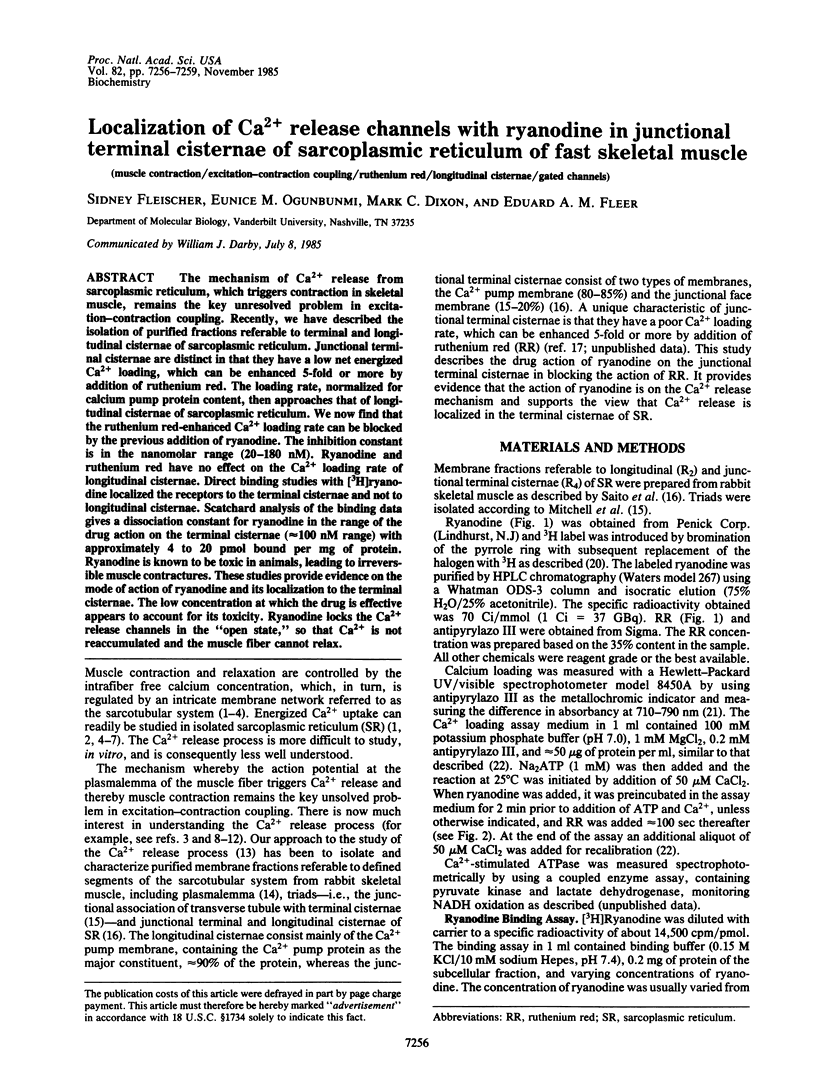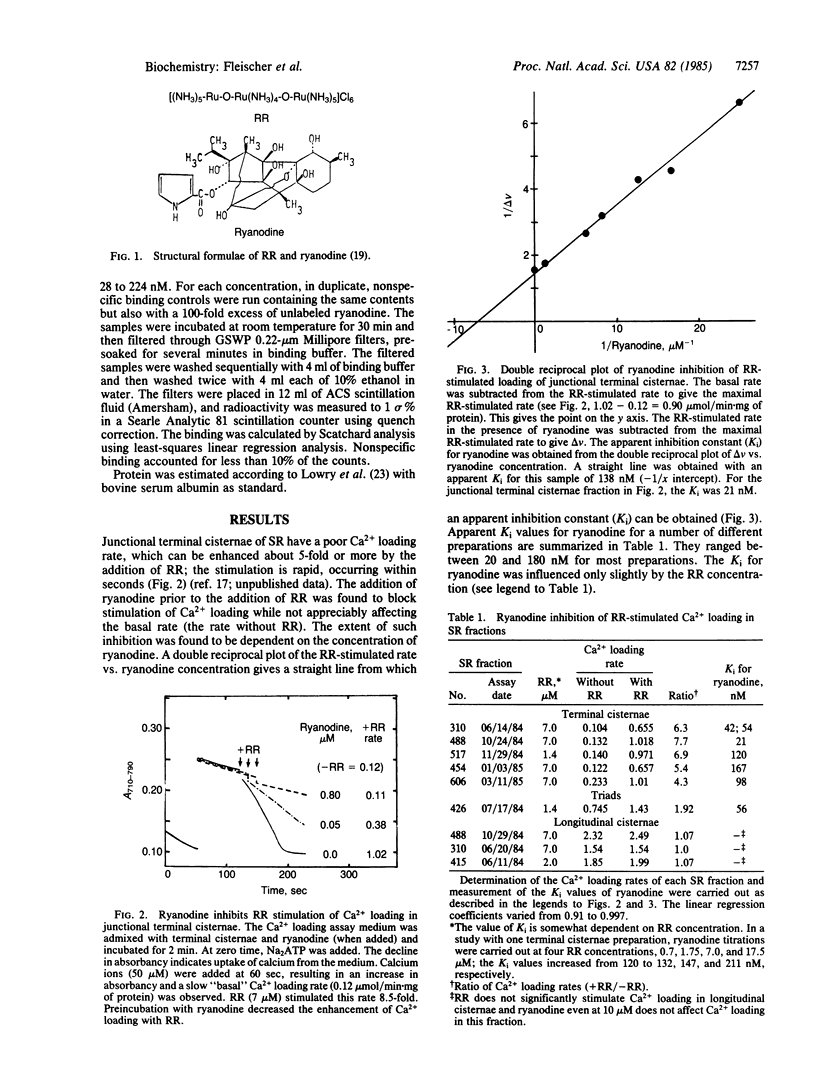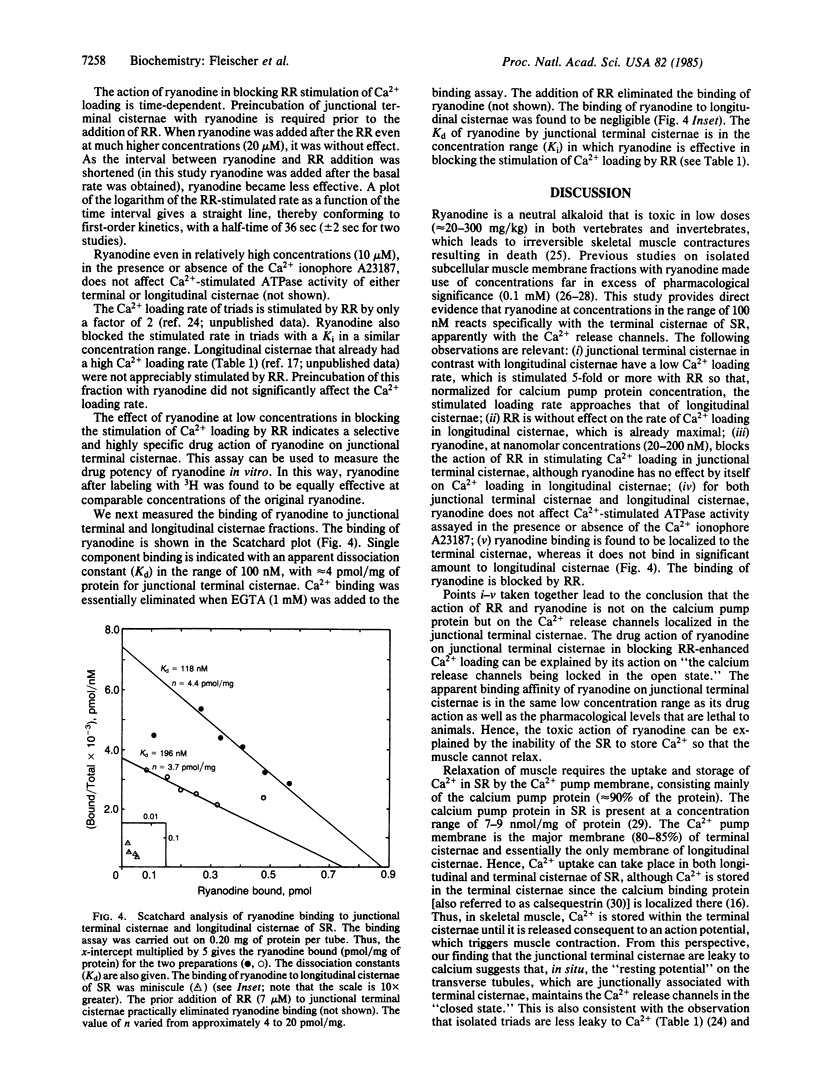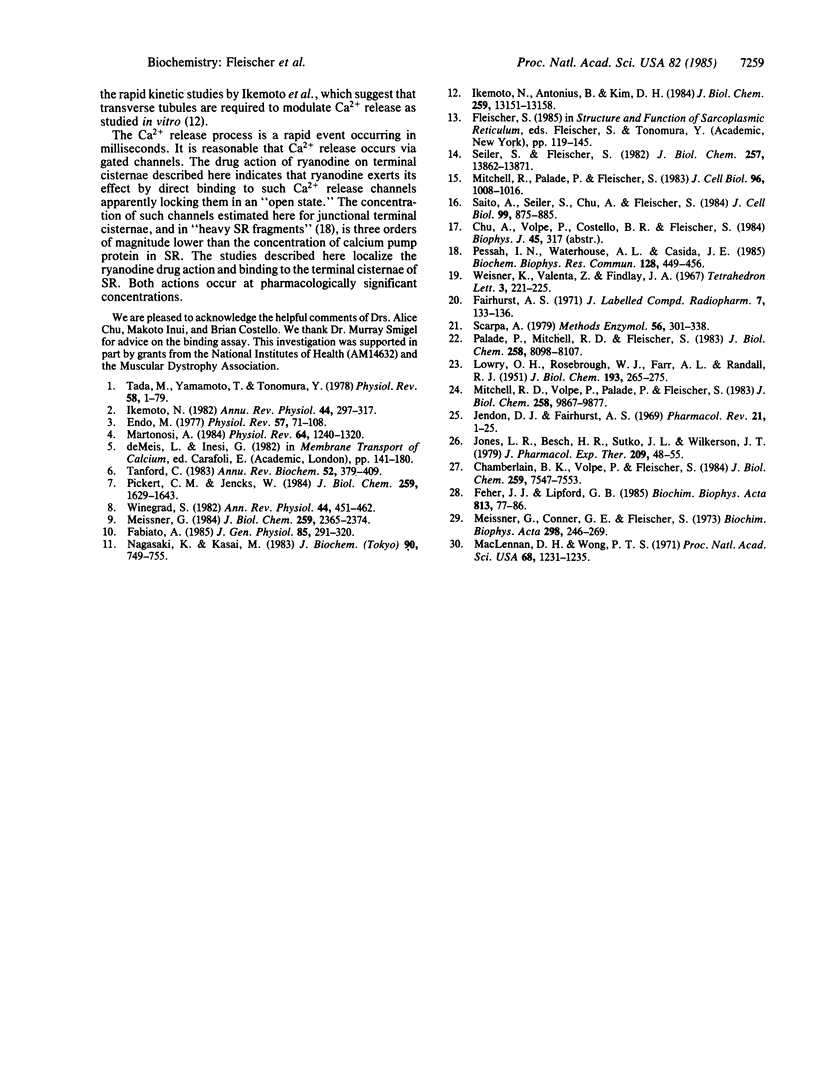Abstract
The mechanism of Ca2+ release from sarcoplasmic reticulum, which triggers contraction in skeletal muscle, remains the key unresolved problem in excitation-contraction coupling. Recently, we have described the isolation of purified fractions referable to terminal and longitudinal cisternae of sarcoplasmic reticulum. Junctional terminal cisternae are distinct in that they have a low net energized Ca2+ loading, which can be enhanced 5-fold or more by addition of ruthenium red. The loading rate, normalized for calcium pump protein content, then approaches that of longitudinal cisternae of sarcoplasmic reticulum. We now find that the ruthenium red-enhanced Ca2+ loading rate can be blocked by the previous addition of ryanodine. The inhibition constant is in the nanomolar range (20-180 nM). Ryanodine and ruthenium red have no effect on the Ca2+ loading rate of longitudinal cisternae. Direct binding studies with [3H]ryanodine localized the receptors to the terminal cisternae and not to longitudinal cisternae. Scatchard analysis of the binding data gives a dissociation constant for ryanodine in the range of the drug action on the terminal cisternae (approximately 100 nM range) with approximately 4 to 20 pmol bound per mg of protein. Ryanodine is known to be toxic in animals, leading to irreversible muscle contractures. These studies provide evidence on the mode of action of ryanodine and its localization to the terminal cisternae. The low concentration at which the drug is effective appears to account for its toxicity. Ryanodine locks the Ca2+ release channels in the "open state," so that Ca2+ is not reaccumulated and the muscle fiber cannot relax.
Full text
PDF



Selected References
These references are in PubMed. This may not be the complete list of references from this article.
- Chamberlain B. K., Volpe P., Fleischer S. Inhibition of calcium-induced calcium release from purified cardiac sarcoplasmic reticulum vesicles. J Biol Chem. 1984 Jun 25;259(12):7547–7553. [PubMed] [Google Scholar]
- Endo M. Calcium release from the sarcoplasmic reticulum. Physiol Rev. 1977 Jan;57(1):71–108. doi: 10.1152/physrev.1977.57.1.71. [DOI] [PubMed] [Google Scholar]
- Fabiato A. Simulated calcium current can both cause calcium loading in and trigger calcium release from the sarcoplasmic reticulum of a skinned canine cardiac Purkinje cell. J Gen Physiol. 1985 Feb;85(2):291–320. doi: 10.1085/jgp.85.2.291. [DOI] [PMC free article] [PubMed] [Google Scholar]
- Feher J. J., Lipford G. B. Mechanism of action of ryanodine on cardiac sarcoplasmic reticulum. Biochim Biophys Acta. 1985 Feb 28;813(1):77–86. doi: 10.1016/0005-2736(85)90347-5. [DOI] [PubMed] [Google Scholar]
- Ikemoto N., Antoniu B., Kim D. H. Rapid calcium release from the isolated sarcoplasmic reticulum is triggered via the attached transverse tubular system. J Biol Chem. 1984 Nov 10;259(21):13151–13158. [PubMed] [Google Scholar]
- Ikemoto N. Structure and function of the calcium pump protein of sarcoplasmic reticulum. Annu Rev Physiol. 1982;44:297–317. doi: 10.1146/annurev.ph.44.030182.001501. [DOI] [PubMed] [Google Scholar]
- Jenden D. J., Fairhurst A. S. The pharmacology of ryanodine. Pharmacol Rev. 1969 Mar;21(1):1–25. [PubMed] [Google Scholar]
- Jones L. R., Besch H. R., Jr, Sutko J. L., Willerson J. T. Ryanodine-induced stimulation of net Ca++ uptake by cardiac sarcoplasmic reticulum vesicles. J Pharmacol Exp Ther. 1979 Apr;209(1):48–55. [PubMed] [Google Scholar]
- LOWRY O. H., ROSEBROUGH N. J., FARR A. L., RANDALL R. J. Protein measurement with the Folin phenol reagent. J Biol Chem. 1951 Nov;193(1):265–275. [PubMed] [Google Scholar]
- MacLennan D. H., Wong P. T. Isolation of a calcium-sequestering protein from sarcoplasmic reticulum. Proc Natl Acad Sci U S A. 1971 Jun;68(6):1231–1235. doi: 10.1073/pnas.68.6.1231. [DOI] [PMC free article] [PubMed] [Google Scholar]
- Martonosi A. N. Mechanisms of Ca2+ release from sarcoplasmic reticulum of skeletal muscle. Physiol Rev. 1984 Oct;64(4):1240–1320. doi: 10.1152/physrev.1984.64.4.1240. [DOI] [PubMed] [Google Scholar]
- Meissner G. Adenine nucleotide stimulation of Ca2+-induced Ca2+ release in sarcoplasmic reticulum. J Biol Chem. 1984 Feb 25;259(4):2365–2374. [PubMed] [Google Scholar]
- Meissner G., Conner G. E., Fleischer S. Isolation of sarcoplasmic reticulum by zonal centrifugation and purification of Ca 2+ -pump and Ca 2+ -binding proteins. Biochim Biophys Acta. 1973 Mar 16;298(2):246–269. doi: 10.1016/0005-2736(73)90355-6. [DOI] [PubMed] [Google Scholar]
- Mitchell R. D., Palade P., Fleischer S. Purification of morphologically intact triad structures from skeletal muscle. J Cell Biol. 1983 Apr;96(4):1008–1016. doi: 10.1083/jcb.96.4.1008. [DOI] [PMC free article] [PubMed] [Google Scholar]
- Mitchell R. D., Volpe P., Palade P., Fleischer S. Biochemical characterization, integrity, and sidedness of purified skeletal muscle triads. J Biol Chem. 1983 Aug 25;258(16):9867–9877. [PubMed] [Google Scholar]
- Nagasaki K., Kasai M. Calcium-induced calcium release from sarcoplasmic reticulum vesicles. J Biochem. 1981 Sep;90(3):749–755. doi: 10.1093/oxfordjournals.jbchem.a133529. [DOI] [PubMed] [Google Scholar]
- Palade P., Mitchell R. D., Fleischer S. Spontaneous calcium release from sarcoplasmic reticulum. General description and effects of calcium. J Biol Chem. 1983 Jul 10;258(13):8098–8107. [PubMed] [Google Scholar]
- Pessah I. N., Waterhouse A. L., Casida J. E. The calcium-ryanodine receptor complex of skeletal and cardiac muscle. Biochem Biophys Res Commun. 1985 Apr 16;128(1):449–456. doi: 10.1016/0006-291x(85)91699-7. [DOI] [PubMed] [Google Scholar]
- Pickart C. M., Jencks W. P. Energetics of the calcium-transporting ATPase. J Biol Chem. 1984 Feb 10;259(3):1629–1643. [PubMed] [Google Scholar]
- Saito A., Seiler S., Chu A., Fleischer S. Preparation and morphology of sarcoplasmic reticulum terminal cisternae from rabbit skeletal muscle. J Cell Biol. 1984 Sep;99(3):875–885. doi: 10.1083/jcb.99.3.875. [DOI] [PMC free article] [PubMed] [Google Scholar]
- Scarpa A. Measurements of cation transport with metallochromic indicators. Methods Enzymol. 1979;56:301–338. doi: 10.1016/0076-6879(79)56030-3. [DOI] [PubMed] [Google Scholar]
- Seiler S., Fleischer S. Isolation of plasma membrane vesicles from rabbit skeletal muscle and their use in ion transport studies. J Biol Chem. 1982 Nov 25;257(22):13862–13871. [PubMed] [Google Scholar]
- Tada M., Yamamoto T., Tonomura Y. Molecular mechanism of active calcium transport by sarcoplasmic reticulum. Physiol Rev. 1978 Jan;58(1):1–79. doi: 10.1152/physrev.1978.58.1.1. [DOI] [PubMed] [Google Scholar]
- Tanford C. Mechanism of free energy coupling in active transport. Annu Rev Biochem. 1983;52:379–409. doi: 10.1146/annurev.bi.52.070183.002115. [DOI] [PubMed] [Google Scholar]
- Winegrad S. Calcium release from cardiac sarcoplasmic reticulum. Annu Rev Physiol. 1982;44:451–462. doi: 10.1146/annurev.ph.44.030182.002315. [DOI] [PubMed] [Google Scholar]


